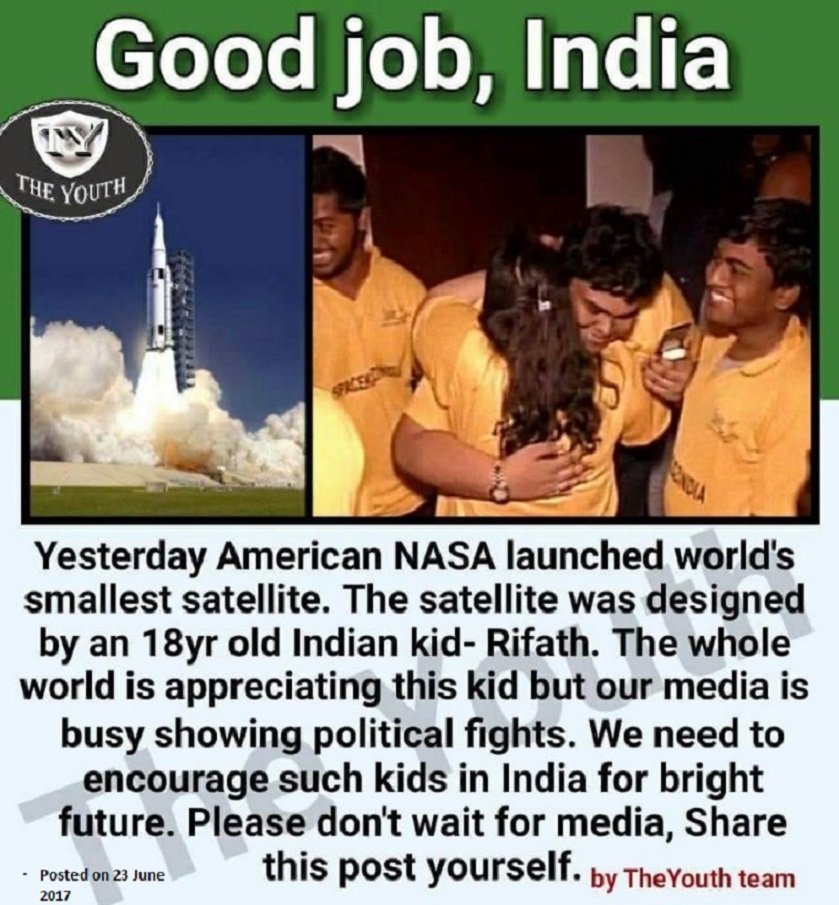Rifath Shaarook
(→After the launch) |
(→What does Kalam Sat do?) |
||
| Line 91: | Line 91: | ||
If it works, that casing will be efficient and affordable to both develop and launch. Shaarook and his team created the satellite and its casing for less than $1,561. | If it works, that casing will be efficient and affordable to both develop and launch. Shaarook and his team created the satellite and its casing for less than $1,561. | ||
| + | |||
| + | |||
| + | = Propaganda that media ignored Rifath= | ||
| + | [[File: Rifath propaganda.jpg| Propaganda that Rifath’s achievement was ignored by the media went viral on the internet and Whatsapp. <br/> It was not the media that was busy showing political fights but organisations like ‘The Youth’ and ‘Unknown Facts’ that were spreading lies to politicise the achievement.|frame|500px]] | ||
| + | |||
| + | |||
| + | Propaganda that Rifath’s achievement was ignored by the media went viral on the internet and Whatsapp (see picture). Organisations like [https://www.google.co.in/search?hl=en&site=imghp&tbm=isch&source=hp&biw=911&bih=441&q=Good+job+india+rifath&oq=Good+job+india+rifath&gs_l=img.12...2007.9689.0.22783.22.22.0.0.0.0.235.2465.0j14j1.15.0....0...1.1.64.img..7.10.1705.0..0j0i30k1j0i8i30k1j0i24k1.deYk9278N-E#imgrc=8QkdAzEcldBJxM: ‘The Youth’] and ‘Unknown Facts’ spread lies to politicise the achievement. Many Whatsapp comments gave a sectarian twist to the alleged media blackout of Rifath’s achievement. | ||
| + | |||
| + | Indpaedia decided to investigate. | ||
| + | |||
| + | Clearly all the media giants like '' The Times of India '' (45 days before the launch, and after), ''The Hindu'' (before the launch, and after), ''Business Standard '' (five weeks before the launch) and ''Economic Times'', and countless smaller Indian media outlets had duly covered Rifath’s work. | ||
| + | |||
| + | When Indpaedia confronted those giving a sectarian twist to the alleged media blackout of Rifath’s achievement on Whatsapp, they tried to wriggle out, saying that they meant that the TV channels had blacked out Rifath’s work. | ||
| + | |||
| + | Indpaedia decided to investigate again | ||
| + | |||
| + | [https://www.youtube.com/watch?v=TqgXHQKQkS0 MEA (Ministry of External Affairs)] had telecast an item six weeks before NASA launched Rifath’s satellite. (1.44 minutes) | ||
| + | |||
| + | So had [https://www.youtube.com/watch?v=IGN86uhUEQY DD News] | ||
| + | |||
| + | …and [https://www.youtube.com/watch?v=JAm3H9unCcg News 18 Tamilnadu] (3.45 minutes). | ||
| + | |||
| + | [https://www.youtube.com/watch?v=oUcprQLWAG0 News 18] did it again (4.12 minutes) around the same time. | ||
| + | |||
| + | [https://www.youtube.com/watch?v=T4R2vDO6l34 News Today] covered the feat five weeks before NASA’s launch (1.37 minutes). | ||
| + | |||
| + | [https://www.youtube.com/watch?v=_JN0n93kdtc&t=5s Thanthi TV], a leading Tamil channel, did so six weeks before the launch, as well as after. | ||
| + | |||
| + | So did [https://www.youtube.com/watch?v=1p5B3ClufPY&t=55s ''India Today''] (2.18 minutes) | ||
| + | |||
| + | …and [https://www.youtube.com/watch?v=QSqK5CwCkv0 NTDTV]. | ||
| + | |||
| + | [http://zeenews.india.com/tags/kalamsat.html Zee News] covered Rifath’s work, three times, before as well as after the launch. | ||
| + | |||
| + | [https://www.youtube.com/watch?v=-bIRzrir9rs ANI/ The Times of India] did so after the launch. | ||
| + | |||
| + | … as did [https://www.youtube.com/watch?v=S1dBtqKRkMY PTI News Corporation] (1.27 minutes) | ||
| + | |||
| + | … while [https://www.youtube.com/watch?v=75LlLg8FTTU MEA (Ministry of External Affairs)] covered it again after the launch. | ||
| + | |||
| + | [https://www.youtube.com/watch?v=dT-UraOEhNI Videsh TV] did several capsules on how the world media covered Rifath’s feat. (This one is 7.34 minutes long.) | ||
| + | |||
| + | Several Tamil channels covered the achievement repeatedly, as did Behindwoods, One India Hindi, One India Tamil and several lesser known Indian TV channels. | ||
| + | |||
| + | It was NOT the media that was busy showing political fights but [https://www.google.co.in/search?hl=en&site=imghp&tbm=isch&source=hp&biw=911&bih=441&q=Good+job+india+rifath&oq=Good+job+india+rifath&gs_l=img.12...2007.9689.0.22783.22.22.0.0.0.0.235.2465.0j14j1.15.0....0...1.1.64.img..7.10.1705.0..0j0i30k1j0i8i30k1j0i24k1.deYk9278N-E#imgrc=8QkdAzEcldBJxM: ‘The Youth’] and ‘Unknown Facts’ were unnecessarily politicising Rifath’s laudable work. | ||
Revision as of 16:30, 5 July 2017
This is a collection of articles archived for the excellence of their content. |
Contents |
About Rifath Shaarook
Name at birth: Mohamed Hussain
In 2017: Lead Scientist at Space Kidz India
Past: Chutti Vikatan
In 2017: Was studying BSc Physics at The New College
Past: Crescent Matriculation Higher Secondary School, Pallapatti
Lives in Pallapatti, Tamil Nadu
Born 2 April
KalamSat
KalamSat, developed by Tamil Nadu's Rifath Sharook, was launched by Nasa rocket on June 21 2017 from a Nasa facility in Wallops Island
When the US’ National Aeronautics and Space Administration (Nasa) launched the world’s smallest satellite KalamSat on June 21, it was the first time ever that it would be piloting an experiment by an Indian student. Developed by Rifath Sharook, an 18-year-old boy, from Tamil Nadu’s Pallapatti town, KalamSat weighs only 64 grammes.
‘KalamSat’, named after India's nuclear scientist and former President, APJ Abdul Kalam, will be launched from a Nasa facility in Wallops Island. Sharook’s project, the first to be manufactured via 3D printing, got selected through a competition, ‘Cubes in Space', sponsored jointly by NASA and 'I Doodle Learning'. The project aims to take the performance of new technology to space.
Key features of the miniature satellite
Sharook said it would be a sub-orbital flight and after launch the mission span would be 240 minutes. The tiny satellite would operate for 12 minutes in a micro-gravity environment of space. “The main role of the satellite will be to demonstrate the performance of 3D-printed carbon fibre”, the Times of India quoted Sharook as saying.
Speaking about his experience, Sharook added: “We designed it completely from scratch. It will have a new kind of on-board computer and eight indigenous built-in sensors to measure acceleration, rotation and the magnetosphere of the earth. The main challenge was to design an experiment to be flown to space which would fit into a four-metre cube weighing 64 grammes”.
His experiment was funded by an organisation called ‘Space Kidz India’, said Sharook, adding he had a great interest in space and he was also a subscriber of the Nasa Kid’s Club.
After the launch
HIGHLIGHTS
The satellite is called Kalamsat and weighs a mere 64 grams.
The satellite was designed by 18-year-old Tamil Nadu student Rifath Sharook and his team.
Kalamsat was the only Indian payload in the Nasa mission.
MUMBAI: On Thursday, India once again broke a global space record by launching the world's lightest satellite weighing a mere 64 grams, called Kalamsat, designed and developed not by professional space scientists and engineers, but by 18-year-old Tamil Nadu student Rifath Sharook and his team.
The tiny satellite, named after Abdul Kalam, was flown by a Nasa sounding rocket and the lift-off was from the space agency's Wallop Island facility around 3pm (IST). Kalam had his training in the sounding rocket programme at Wallops Island in the '60s. Kalamsat was the only Indian payload in the mission.
Speaking to TOI post Speaking to TOI post launch from Chennai, mission director Srimathy Kesan said that the total flight time of the rocket was 240 minutes and the satellite, assembled at her T.Nagar residence in Chennai, separated from the rocket 125 minutes after lift-off.
"Kalamsat fell into the sea. It will be recovered and Nasa will be sending it back to us for decoding the data, she said while pointing out in an emotion-choked voice that the flight was "out of the world and it was a divine intervention."
Explained Kesan: "I am calling it divine intervention because the previous Nasa mission from Wallops got postponed because of weather and we were able to launch successfully today." This one-of-itskind satellite, which can be held in one's palm is a 3.8cm cube and its structure is fully 3-D printed with reinforced carbon fiber polymer. It is equipped with a nano Geiger Muller counter which will measure radiation in space. Added Kesan: "It is the only cube to be converted into a satellite in this mission," she added.
National Geographic’s discussion
An Indian teenager has not only produced A 64-gram (0.14-pound) satellite, NASA has agreed to launch it. (Science Alert)
What is a satellite?
Rifath Shaarook, an 18-year-old Indian teenager, just designed Kalam Sat, the world’s lightest satellite. What is a satellite?
NASA says:
A satellite is any object that orbits around another object. (Learn about orbits here.) Satellites can be natural or artificial.
Natural satellites include objects such as the Moon, which orbits the Earth, and the Earth itself, which orbits the sun.
Artificial satellites include any of the thousands of objects launched into orbit from spaceports on Earth. Artificial satellites are used for everything from measuring and tracking weather, to coordinating our GPS, to helping archaeologists identify potential dig sites, to counting penguins, to zooming in on Earth and peering into outer space.
What does Kalam Sat do?
Kalam Sat will actually have a suborbital spaceflight, meaning it will reach space, but not complete an orbital revolution. It will be operated for about 12 minutes before crashing back to Earth.
According to Science Alert, “its main objective will be to test the durability of its extremely light, 3D-printed casing” in the microgravity of outer space.
The Kalam Sat’s casing is made of carbon fiber reinforced polymer, a very strong, light plastic.
The instruments of the Kalam Sat itself will be housed inside the casing. “It will have a new kind of onboard computer and eight … built-in sensors to measure acceleration, rotation, and the magnetosphere of Earth,” says Shaarook.
What makes the Kalam Sat’s casing so intriguing to NASA and the rest of the space community?
If it works, that casing will be efficient and affordable to both develop and launch. Shaarook and his team created the satellite and its casing for less than $1,561.
Propaganda that media ignored Rifath
Propaganda that Rifath’s achievement was ignored by the media went viral on the internet and Whatsapp (see picture). Organisations like ‘The Youth’ and ‘Unknown Facts’ spread lies to politicise the achievement. Many Whatsapp comments gave a sectarian twist to the alleged media blackout of Rifath’s achievement.
Indpaedia decided to investigate.
Clearly all the media giants like The Times of India (45 days before the launch, and after), The Hindu (before the launch, and after), Business Standard (five weeks before the launch) and Economic Times, and countless smaller Indian media outlets had duly covered Rifath’s work.
When Indpaedia confronted those giving a sectarian twist to the alleged media blackout of Rifath’s achievement on Whatsapp, they tried to wriggle out, saying that they meant that the TV channels had blacked out Rifath’s work.
Indpaedia decided to investigate again
MEA (Ministry of External Affairs) had telecast an item six weeks before NASA launched Rifath’s satellite. (1.44 minutes)
So had DD News
…and News 18 Tamilnadu (3.45 minutes).
News 18 did it again (4.12 minutes) around the same time.
News Today covered the feat five weeks before NASA’s launch (1.37 minutes).
Thanthi TV, a leading Tamil channel, did so six weeks before the launch, as well as after.
So did India Today (2.18 minutes)
…and NTDTV.
Zee News covered Rifath’s work, three times, before as well as after the launch.
ANI/ The Times of India did so after the launch.
… as did PTI News Corporation (1.27 minutes)
… while MEA (Ministry of External Affairs) covered it again after the launch.
Videsh TV did several capsules on how the world media covered Rifath’s feat. (This one is 7.34 minutes long.)
Several Tamil channels covered the achievement repeatedly, as did Behindwoods, One India Hindi, One India Tamil and several lesser known Indian TV channels.
It was NOT the media that was busy showing political fights but ‘The Youth’ and ‘Unknown Facts’ were unnecessarily politicising Rifath’s laudable work.

